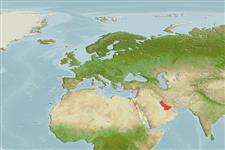Classificação / Names
Nomes comuns | Sinónimos | Catalog of Fishes(Género, Espécies) | ITIS | CoL | WoRMS | Cloffa
>
Aulopiformes (Grinners) >
Synodontidae (Lizardfishes) > Harpadontinae
Etymology: Saurida: Derived from Greek, sauros = lizard (Ref. 45335); lessepsianus: Name referring to its distribution in both the Red Sea and eastern Mediterranean Sea, it having migrated from the Red Sea to the Mediterranean via the Suez Canal, known as 'Lessepsian migration'..
Environment: milieu / climate zone / depth range / distribution range
Ecologia
marinhas bentopelágico; intervalo de profundidade 20 - 200 m (Ref. 101631), usually 20 - 30 m (Ref. 101631). Subtropical; 30°N - 12°N, 32°E - 73°E
Western Indian Ocean: widespread in the Red Sea, including the Gulf of Suez where it is very common; lessepsian migrant in the Mediterranean Sea.
Tamanho / Peso / Idade
Maturity: Lm ? range ? - ? cm
Max length : 28.2 cm SL macho/indeterminado; (Ref. 101631)
Descrição breve
Chaves de identificação | Morfologia | Morfometria
Raios dorsais moles (total) : 11 - 12; Raios anais moles: 10 - 12; Vértebras: 44 - 47. This species is distinguished by the following set of characters: 11-12 dorsal fin-rays; 13-15 pectoral fin-rays; 47-51 lateral-line scales; 4½ transverse scale rows above lateral line, 5½ below lateral line; moderately long pectoral fins (tip of fin extending to between just before or just beyond a line from origin of pelvic fins to origin of dorsal fin); outer palatines with 2 rows of teeth; vomer with 0-2 teeth; tongue with 3-6 rows of teeth posteriorly; slightly compressed caudal peduncle (depth a little more than width); upper margin of caudal fin has a row of 3-8 (usually 6 or 7) distinct blackish spots; color of stomach pale grey to blackish anteriorly; intestine whitish (Ref. 101631).
The species is found mainly on sandy or muddy substrates to about 100 m, but observed to be more common inshore close to islands or coasts in depths of 20-30 m. Mainly piscivorous. Spawning season prolonged and occurs nearly all the year round, in the Gulf of Suez with two peaks in December and May (El-Halfawy et al. 2007). In the Mediterranean, spawning season off the coast of Israel lasts from March to December (Golani 1993), whereas at Iskenderun Bay, Turkey, spawning occurs mainly in two seasons (May-July and September-November) (İşmen 2003). Reported to be important in the trawl fishery of the Gulf of Suez and the Mediterranean coast of Egypt, where it is in a state of high overfishing and severe overexploitation. In the Mediterranean, it was rather uncommon until 1955, when it started to appear in large quantities in bottom trawl catches (according to Ben-Yami & Glaser 1974, Ref. 1289; Bilecenoğlu 2010, Ref. 94612); catches have since remained high, with some fluctuations (Golani 1993, Ref. 38081). Also reported to be an economically important fish in the Mersin and Iskenderun Gulfs, Turkey and is among the most common species caught in the trawl fishery, comprising almost one-third of the commercial trawl catch in the north-eastern Levant (Ref. 101631).
Life cycle and mating behavior
Maturities | Reprodução | Spawnings | Egg(s) | Fecundities | Larvas
Russell, B.C., D. Golani and Y. Tikochinski, 2015. Saurida lessepsianus a new species of lizardfish (Pisces: Synodontidae) from the Red Sea and Mediterranean Sea, with a key to Saurida species in the Red Sea. Zootaxa 3956(4):559-568. (Ref. 101631)
Categoria na Lista Vermelha da IUCN (Ref. 130435)
Ameaça para o homem
Harmless
Utilização humana
Ferramentas
Relatórios especiais
Descarregue XML
Fontes da internet
Estimates based on models
Phylogenetic diversity index (Ref.
82804): PD
50 = 0.5000 [Uniqueness, from 0.5 = low to 2.0 = high].
Bayesian length-weight: a=0.00501 (0.00236 - 0.01065), b=3.10 (2.93 - 3.27), in cm total length, based on LWR estimates for this Genus-body shape (Ref.
93245).
Nível Trófico (Ref.
69278): 4.0 ±0.67 se; based on food items.
Resiliência (Ref.
120179): Elevada, tempo mínimo de duplicação da população menor que 15 meses (Preliminary K or Fecundity.).
Fishing Vulnerability (Ref.
59153): Low vulnerability (24 of 100).
